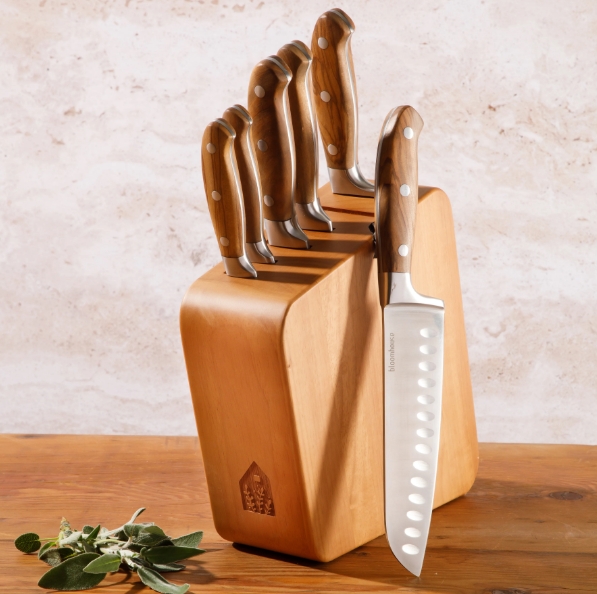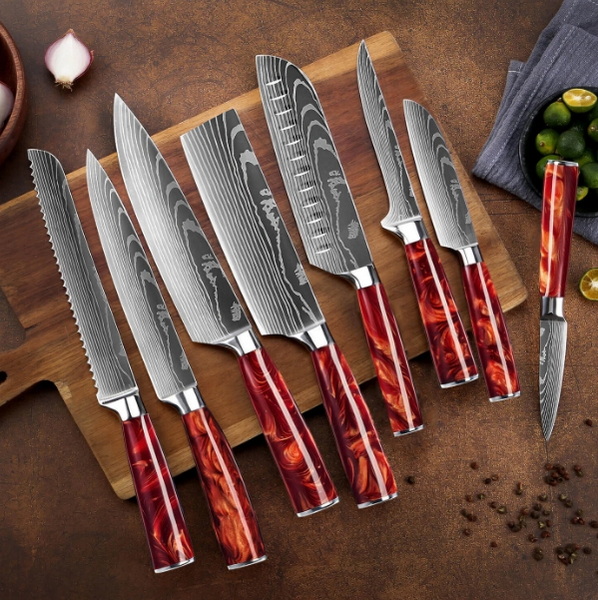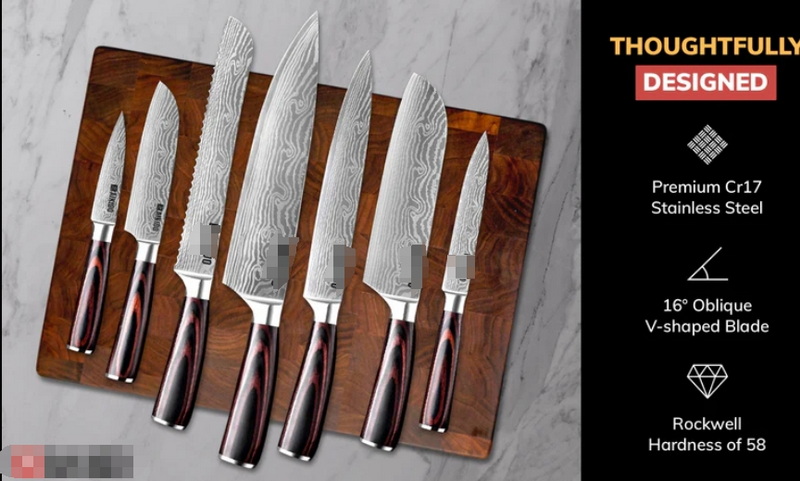

Views: 222 Author: Ella Publish Time: 2025-05-05 Origin: Site








Content Menu
● Sharpness: The Heart of a Good Chef Knife
● Blade Material: The Foundation of Performance and Durability
● Blade Design and Length: Versatility and Comfort in Use
● Handle Comfort and Material: Control and Safety
● Edge Retention and Maintenance: Longevity of Performance
● Versatility and Purpose: Matching Knife to Task
● Additional Factors That Influence Chef Knife Quality
>> Heat Treatment and Blade Hardening
>> Weight Distribution and Balance
>> Craftsmanship and Brand Reputation
● FAQ
>> 1. What is the best blade material for a chef knife?
>> 2. How long should a chef knife blade be?
>> 3. Why is a full tang important in a chef knife?
>> 4. How do I maintain the sharpness of my chef knife?
>> 5. What handle materials are best for comfort and durability?
A chef knife is the cornerstone of any kitchen, whether you are a professional chef or a passionate home cook. But what truly defines a good quality chef knife? Beyond just looking sharp and stylish, a high-quality chef knife combines craftsmanship, materials, design, and comfort to deliver superior performance and durability. This comprehensive guide explores the essential qualities that make a chef knife stand out, helping you choose the perfect blade for your culinary needs.

A chef knife's sharpness is the most critical factor in its quality. A razor-sharp edge allows for effortless, precise cuts, reducing the risk of slipping and accidents. High-quality knives come with a factory edge sharp enough to slice through paper cleanly right out of the box. Moreover, a good knife maintains its sharpness over time with regular honing and proper care, typically lasting six to twelve months before needing professional sharpening.
The blade's edge angle plays a vital role in sharpness. Japanese-style knives often feature a sharper, narrower edge, typically around eight to twelve degrees per side. This narrow angle creates an incredibly precise edge that can glide through ingredients with minimal resistance. However, such sharpness comes at a cost: these edges tend to be more delicate and require careful handling to avoid chipping. In contrast, Western knives usually have a broader edge angle, often around fifteen to twenty degrees per side. This results in a more robust edge that withstands heavy-duty chopping and cutting but may not be as razor-sharp as Japanese blades.
The sharpness of a knife also affects the quality of your food preparation. A dull blade crushes and tears food cells, which can alter the texture and flavor of delicate ingredients like herbs and vegetables. A sharp knife ensures clean cuts, preserving the integrity and appearance of the food.
The material used for the blade greatly influences a chef knife's sharpness, edge retention, corrosion resistance, and overall durability. Understanding the different types of steel and their properties can help you make an informed choice.
- High Carbon Stainless Steel: This is the most favored material among chefs for its excellent balance of hardness, corrosion resistance, and edge retention. High carbon stainless steel contains a higher percentage of carbon compared to regular stainless steel, which allows the blade to be hardened more effectively. The addition of chromium makes the blade resistant to rust and stains, making it ideal for everyday kitchen use. Knives made from this material can maintain a sharp edge for a long time while being relatively easy to sharpen.
- Carbon Steel: Known for its outstanding sharpness and edge retention, carbon steel blades are easier to sharpen but prone to rust and discoloration if not properly maintained. The lack of chromium means these knives require diligent care, including thorough drying after washing and occasional oiling. Many professional chefs prefer carbon steel for its superior cutting performance and the beautiful patina it develops over time, which can add character to the blade.
- Stainless Steel: Durable and resistant to rust and stains, stainless steel knives are common in home kitchens. However, they tend to lose their sharp edge faster than high carbon steel and need more frequent sharpening. Stainless steel knives are often more affordable and require less maintenance, making them a practical choice for casual cooks.
- Damascus Steel: Often prized for its beautiful layered patterns, Damascus steel knives combine aesthetics with strength and sharpness. They are usually crafted by layering different steels, offering a balance of hardness and flexibility. While Damascus steel knives can be more expensive, many chefs appreciate their unique look and excellent cutting performance.
The choice of blade material ultimately depends on your cooking style, maintenance preferences, and budget. High carbon stainless steel offers the best all-around performance, while carbon steel appeals to those who want the sharpest edge and don't mind extra care.
The shape and length of the blade affect how the knife handles various kitchen tasks and how comfortable it feels during extended use.
- Blade Length: An eight-inch blade is generally considered the most versatile and manageable size for most cooks. It is long enough to handle large vegetables and meats but still easy to control. For smaller hands or more delicate tasks, a six-inch blade might be preferable, while professional chefs who work with large cuts of meat might opt for a ten-inch or longer blade. The key is to find a length that feels balanced and comfortable in your hand.
- Blade Shape: The classic chef knife features a gently curved edge, which facilitates a rocking motion when chopping herbs and vegetables. This curve allows the tip and heel of the blade to remain in contact with the cutting board, improving efficiency and control. Some knives have a straighter edge, better suited for slicing tasks where a smooth, clean cut is essential. The blade's thickness also impacts its ability to cut through tougher ingredients without bending or breaking. Thicker blades provide strength for heavy-duty chopping, while thinner blades excel at precision slicing.
- Full Tang Construction: A full tang means the blade extends through the entire length of the handle, providing better balance, strength, and durability. Knives with full tangs are less likely to break and feel more secure in hand. Partial tang knives, where the blade extends only partway into the handle, are generally less durable and may feel unbalanced.
- Blade Weight and Balance: The overall weight and balance of the knife influence comfort and control. Some chefs prefer heavier knives that provide momentum for chopping, while others favor lighter knives for agility and precision. A well-balanced knife feels natural in the hand, with the weight evenly distributed between the blade and handle.

A knife's handle is crucial for comfort, control, and safety during use. The best chef knives feature handles that fit comfortably in your hand, reducing fatigue and improving precision.
- Material: Handles are commonly made from wood, composite materials, plastic, or metal. Wood offers a traditional feel but may require more maintenance to avoid warping or cracking. High-quality hardwoods like pakkawood or stabilized wood combine beauty with durability. Composite materials, such as micarta or resin-infused wood, are durable, resistant to moisture, and easy to clean. Plastic handles are lightweight and inexpensive but may feel less substantial. Metal handles, often stainless steel or aluminum, are sturdy but can become slippery when wet and may feel cold or heavy.
- Ergonomics: A well-designed handle provides a secure grip and prevents slipping. Some knives have contoured handles that fit the natural curve of your hand, while others offer textured surfaces for extra grip. Ergonomic handles reduce hand fatigue during prolonged use and enhance control for precise cuts.
- Bolster and Finger Guard: The bolster is the thick junction between the blade and handle. Full bolsters offer protection for novice users by preventing fingers from slipping onto the blade, whereas semi-bolsters or no bolsters provide more control for experienced chefs who prefer a pinch grip. Some modern knives have a finger guard or textured bolster to improve safety without sacrificing maneuverability.
- Handle Shape: Handles can be straight, oval, or D-shaped. Oval and D-shaped handles provide a more secure grip, especially when hands are wet or greasy. The shape should allow you to hold the knife comfortably in various grips, including the handle grip and the pinch grip.
A good chef knife should not only be sharp but also maintain its edge through regular use. Edge retention depends on the steel's hardness, blade thickness, and bevel angle.
- Hardness: Measured on the Rockwell scale, harder steels hold a sharper edge longer but may be more brittle and prone to chipping. Softer steels are more durable but require more frequent sharpening. Most high-quality chef knives have a hardness rating between 56 and 62 on the Rockwell scale, balancing sharpness and toughness.
- Maintenance: Proper care extends a knife's life. Hand washing and drying immediately after use prevent rust and corrosion. Avoid putting knives in the dishwasher, as harsh detergents and high heat can damage the blade and handle. Storing knives safely in a knife block, magnetic strip, or blade guard prevents dulling and accidents.
- Honing: Regular honing with a honing rod realigns the blade's edge, keeping it sharp between sharpenings. Honing does not remove metal but straightens microscopic bends in the edge caused by use.
- Sharpening: When the blade becomes noticeably dull, professional sharpening or using a whetstone restores the edge. Sharpening removes metal to create a new edge, so it should be done carefully to avoid excessive wear.
While the chef knife is versatile, some blades are better suited for specific tasks:
- All-Purpose Use: A good chef knife can chop, slice, dice, and mince a variety of ingredients efficiently. It can handle vegetables, fruits, meats, and herbs with ease.
- Specialized Blades: Bread knives have serrated edges for slicing crusty loaves without crushing. Paring knives excel at delicate peeling and trimming. Santoku knives, a Japanese style similar to the chef knife, feature a shorter, wider blade with a flat edge and grant versatility in slicing and dicing.
- Choosing the Right Knife: Consider your cooking habits and preferences. If you often prepare large cuts of meat, a longer, heavier knife might be ideal. For intricate vegetable work, a lighter, sharper blade may be better. Many chefs maintain a small collection of knives tailored to different tasks.
The process of heat treating a blade is crucial in determining its hardness and toughness. Heat treatment involves heating the steel to a specific temperature and then cooling it rapidly to harden the metal. This process is followed by tempering, which reduces brittleness while maintaining hardness. A well-heat-treated blade strikes a balance between edge retention and resistance to chipping or breaking. Knives from reputable manufacturers undergo precise heat treatment to ensure consistent performance.
The finish of the blade can affect its performance and maintenance. A polished finish reduces friction, allowing the blade to glide smoothly through food. Some knives feature non-stick coatings or textured finishes that reduce food sticking to the blade, making slicing easier and cleaning faster. However, coatings can wear off over time and may require special care.
The feeling of a knife in your hand depends heavily on its weight distribution. A well-balanced knife feels natural and comfortable, reducing hand fatigue during prolonged use. Some knives are blade-heavy, which can be advantageous for chopping tasks, while others have a handle-heavy design for better control in slicing. The ideal balance depends on personal preference and cooking style.
The quality of craftsmanship is often reflected in the attention to detail, fit and finish, and consistency of the knife. Handmade knives or those from renowned brands usually undergo rigorous quality control. Investing in a knife from a reputable maker often ensures better materials, superior construction, and excellent customer support.
A good quality chef knife is defined by a blend of sharpness, durable blade material, ergonomic handle design, and excellent edge retention. High carbon stainless steel blades with full tang construction and comfortable handles offer the best combination of performance and longevity. Choosing the right blade length and design tailored to your cooking needs enhances versatility and safety. Proper maintenance ensures your knife remains a reliable kitchen companion for years to come.
Investing in a quality chef knife not only improves your cooking experience but also encourages safer, more efficient food preparation. Understanding the factors that contribute to knife quality empowers you to make an informed choice and take better care of your tools.

High carbon stainless steel is widely regarded as the best material due to its balance of sharpness, edge retention, corrosion resistance, and durability. Carbon steel offers superior sharpness but requires more care, while stainless steel is durable but loses sharpness faster.
An eight-inch blade is the most popular and versatile size, suitable for a wide range of kitchen tasks. However, blade length can vary depending on personal preference and the type of cooking you do.
A full tang means the blade extends through the handle, providing better balance, strength, and durability. It ensures the knife feels secure and stable during use, reducing the risk of breakage.
Regular honing, hand washing and drying immediately after use, safe storage, and periodic professional sharpening help maintain a knife's sharpness and prolong its lifespan.
Wood handles offer a traditional feel but may require more maintenance. Composite and plastic handles are durable and easy to clean, while metal handles are sturdy but can be slippery. Choose a handle that feels comfortable and secure in your hand.